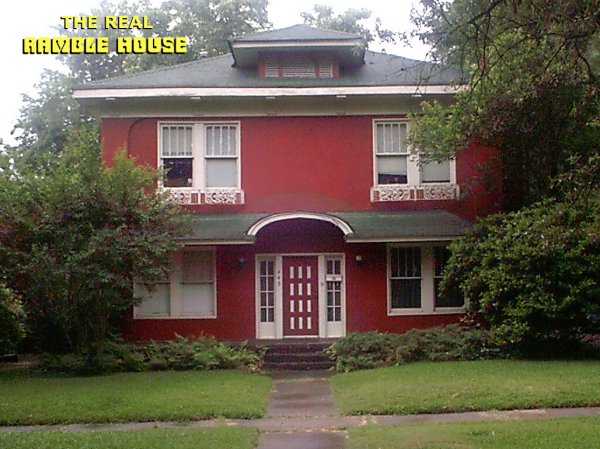 Photo by Knees Calhoon |
THE RAMBLE HOUSE STORY by Fender Tucker
The saga of two men and their childish dreams of world domination through gonzo publishing and home book-binding. |
Ramble House was inevitable. In the early 20th Century, as soon as it became possible to record sound and pictures, people wanted this ability for themselves. Over the years the media changed (film, wire, acetate, reel-to-reel tape, video-tape, floppy disk, CD, DVD, etc.) but one thing remained the same: if a person bought something, he damn well expected to be able to make a copy so he wouldn't have to buy it again when it wore out.
But what about the oldest medium of them all? Books. Why can't people make copies of books they buy just as they can the other media? Well, it turns out that if you're a genius like Jim Weiler it's not much of a problem at all.
In the late 1990s, Jim and I were languishing in Shreveport Louisiana at a software company, Softdisk, which used to be a major player in the early days of home computing. But the days when people would pay to have new soft-ware delivered to their door every month were numbered —the Internet provided way too much software for free—so Jim decided to look into other ways of making his computer expertise pay off. He tried e-books, which were barely in their infancy at the time. He started converting old public-domain books into electronic text and his project, The Naked Word, soon had over 100 classic books available as text files for PC users. His newer site, xooqi, (iboox upside down) has provided over 50,000 e-texts to bookloving free-booters.
Since those early days of e-text the concept has come a long way and now major publishing companies are gambling that people will read books on electronic "palm readers". But for someone like Jim Weiler, the idea was too "logical", too "reasonable"; he preferred to look beyond the obvious and foresaw a day when people who love reading real books will insist on having backups of their favorites. And they'll want them on paper and handy to carry around—unlike e-books.
But surely the book-making technology is already in place? It's been around since Gutenberg. If you need a back-up book, just buy a printing press and learn the art of typesetting. Or call a Vanity Press and get 500 copies made for a few thousand bucks.
Well, what Jim had in mind was true home-publishing: the ability to make books, one at a time, using normal household items, for a reasonable amount of labor and expense. It took him three reams of paper, two laser toner cartridges, and scores of trials and errors, but by 1999 he figured out how to make a nifty paperback copy of any old book at home. Then he taught me how to do it.
I was the old man at Softdisk, veteran bookphile and posterboy for the proposition that too much reading can make a man dull and lifeless. I liked to read about writing almost as much as I liked writing itself, and I thought that I knew every old mystery author there was, from Edgar Allan Poe through Dashiell Hammett to James Crumley. But until I read about Harry Stephen Keeler in Bill Pronzini's Son of Gun in Cheek, I had never heard of him! That's what amazed me about him. How could he have been so forgotten? Was there a conspiracy among crime buffs against him?
And it wasn't just a lack of mention in the books about mystery writing. I was a used bookstore lurker. Whenever I'd stop in a strange town while driving across America, I'd check out the used bookstores. I still do and it drives my wife crazy. But as of March 12, 2003 I have yet to find a single copy of a Keeler novel on a bookstore shelf! And I've been looking for them for about six years now. Keeler has almost disappeared from the face of the earth.
So I turned to an old friend and ally in the quest for books not deemed reprintable for the modern masses: the local library. There were no Keelers there, of course, but through inter-library loans I was able to obtain a couple dozen of HSK's novels—beat-up, worn-out, re-covered copies that were 50 years old or more.
And this was at the same time that Jim figured out how to make copies of old books at home. We combined our various obsessive-compulsive neuroses and created Ramble House—the house that will not sleep until all of Harry Stephen Keeler's mystery novels are back in print for a reasonable price. At the time of this writing, Ramble House has about 60 of Keeler’s novels scanned, OCRed, typeset and proofread—available for anyone to buy. Since some of Harry's juggernauts are huge—several were over 500 pages long—we have had to break some up into volumes. It’s no more fun binding a huge paperback than it is lugging it around. Ramble House books are made to fit into a pocket for easy carrying.
Before long, we had found other authors whose books deserve to be read, but had been forgotten. Mike Nevins came up with a great metaphor for Ramble House—"loon sanctuary"—and the rest is history.